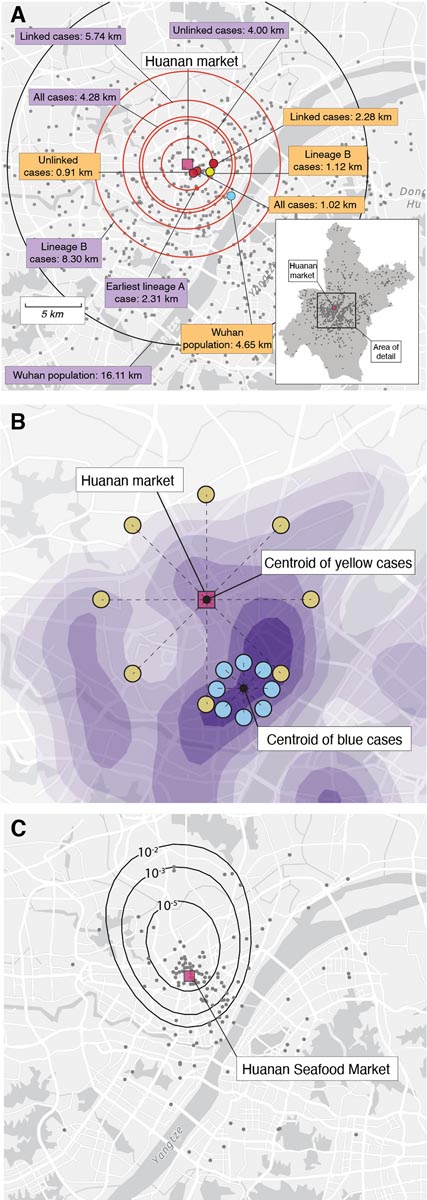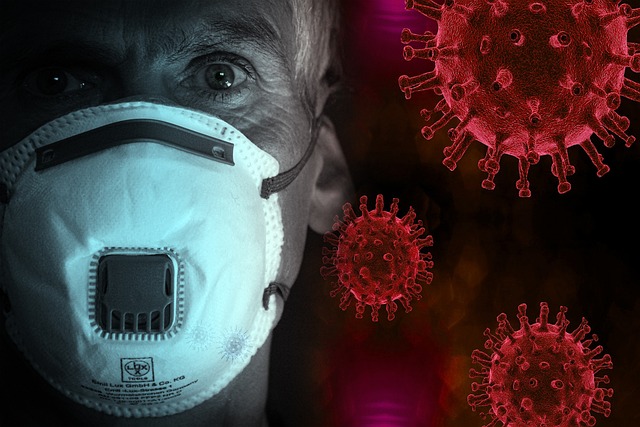Summary Understanding how severe acute respiratory syndrome coronavirus 2 (SARS-CoV-2) emerged in 2019 is critical to preventing zoonotic outbreaks before they become the next pandemic. The Huanan Seafood Wholesale Market in Wuhan, China, was identified as a likely source of cases in early reports, but this conclusion later became controversial. We show that the first known COVID-19 cases from December 2019, including those without reported direct links, were geographically centered on this market. We reported that live mammals susceptible to SARS-CoV-2 were sold on the market in late 2019, and within the market, SARS-CoV-2-positive environmental samples were spatially associated with vendors selling live mammals. While there is insufficient evidence to define the above events and the exact circumstances remain obscure, our analyzes indicate that the emergence of SARS-CoV-2 occurred through the wildlife trade in China and show that the Huanan market was the epicenter of the COVID-19 pandemic. |

Spatial analysis. (A) Inset: Map of Wuhan, with gray dots indicating 1000 random samples from the worldpop.com null distribution. Main panel: Mean distance between Huanan market and (1) the worldpop.org null distribution is shown with a black circle and (2) December cases are shown with red circles (distance to Huanan market is shown in purple boxes). Center point of Wuhan population density data shown by a blue dot. Center points of December case locations are shown with red dots (’all’, ’linked’ and ’unlinked’ cases); dark blue dot (lineage A cases); and yellow dot (cases of lineage B). Distance from central points to Huanan market represented in orange boxes. (B) Schematic showing how cases can be close, but not centered on a specific location. We hypothesize that if the Huanan market is the epicenter of the pandemic, the first cases should not only be unexpectedly close to it, but also unexpectedly centered on it (see Methods). The blue cases show how the cases quite close to the Huanan market, however, cannot be focused on it. (C) Tolerance contours based on relative risk of COVID-19 cases in December 2019 versus data from January to February 2020. Dots show locations of December cases. The contours represent the probability of observing that density of December cases within the boundaries of the given contour if the December cases had been drawn from the same spatial distribution as the January-February data.
Comments
An international team of 18 researchers, including a scientist from the University of Utah Health, determined that the first human cases of COVID-19 emerged at a wholesale fish market in Wuhan, China, in December 2019. They linked these cases to bats. , foxes and other live mammals infected with the virus sold on the market either for consumption as meat or for their fur.
The finding, published in Science , confirms early reports, later dismissed by senior Chinese officials, that live animals sold at the Huanan seafood wholesale market were the likely source of the pandemic that has claimed at least 6.4 million. It has been around since it first emerged in China almost three years ago.
“These are the most compelling and detailed studies of what happened in Wuhan in the early stages of what would become the COVID-19 pandemic,” says Stephen Goldstein, Ph.D., co-author of the study led by the lead author. . Kristian Anderson, Ph.D., of the Scripps Research Institute in La Jolla and first author Michael Worobey, Ph.D., of the University of Arizona. Goldstein is a postdoctoral researcher in the Human Genetics department at U of U Health. “We have convincingly shown that sales of wild animals at the Huanan market in Wuhan are implicated in the first human cases of the disease.”
Among the key findings of the study:
- The emergence of SARS-CoV-2, the virus that causes COVID-19, can probably be attributed to one or more of the 10 to 15 market stalls selling live dogs, rats, porcupines, badgers, hares, foxes, hedgehogs , marmots and Chinese muntjac (a small deer). Health officials and researchers detected SARS-CoV-2 in animal cages, carts, and drainage grates at these locations.
- The only areas where the virus was spreading in December 2019 were neighborhoods within a half mile of the market. Previously, some researchers suggested that the virus was brought into the market from another part of the city and spread among its customers. Instead, the new findings strongly suggest that the virus originated in the market through the sale of live animals and slowly spread from there to nearby neighborhoods and then to the city as a whole.
- Two variants of the SARS-CoV-2 virus were detected on the market. That suggests that both variants originated independently in the market and helps confirm the researchers’ hypothesis that the early spread of the infection began there. If the virus originated elsewhere, it is more likely that only one variant was found.
Going forward, researchers say public officials should seek a better understanding of the wildlife trade in China and elsewhere and promote more extensive testing of live animals sold in markets to reduce the risk of future pandemics.
Discussion
Several lines of evidence support the hypothesis that the Huanan market was the epicenter of the COVID-19 pandemic and that SARS-CoV-2 emerged from activities associated with the live wildlife trade. Spatial analyzes within the market show that SARS-CoV-2-positive environmental samples, including cages, carts, and freezers, were associated with activities concentrated in the southwest corner of the market. This is the same section where vendors were selling live mammals, including raccoon dogs, hog badgers and red foxes, immediately before the COVID-19 pandemic.
Multiple positive samples were taken from a stall known to have sold live mammals, and the water drain next to this stall, as well as other sewers and a nearby wildlife stall on the southwest side of the market, tested positive for SARS-CoV -2. These findings suggest that infected animals were present at the Huanan market at the beginning of the COVID-19 pandemic; however, we do not have access to live animal samples of relevant species. Additional information, including sequencing data and detailed sampling strategy, would be invaluable to comprehensively test this hypothesis.
















